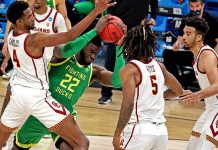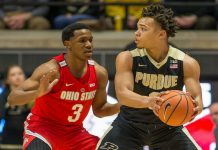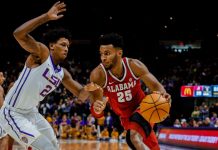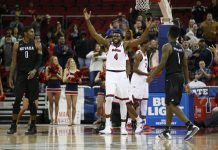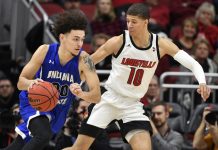The NCAA moved back the 3-point line this season to create more room in the lane and cut down on the barrage of 3s in college basketball.
Shooting percentages are down, historically low. Attempts also have dropped, slightly.
Clogged lanes? Depends on who you ask.
”I don’t think it’s changed a lot,” Kansas guard Marcus Garrett said. ”I just feel like a lot more shots are being missed.”
He’s right.
With teams heavily relying on 3-pointers more and percentages steadily rising, the NCAA moved the arc back nearly two feet to 22 feet, 1} inches this season. That matches the international distance, but short of the NBA arc at 23 feet, nine inches.
The goal was to make the lane more available for drives, cut down on the prevalence of 3-pointers and create more offensive spacing.
The result, at least from the arc, is teams are missing at an historic rate.
Division I teams are shooting 33.3% so far this season, lowest since the 3-point line was added to college basketball in 1986-87, according to KenPom.
Maryland Eastern Shore, annually one of the nation’s worst 3-point shooting teams, is last in Division I at 24.9%. Kennessaw State is right behind the Hawks at 25.1%.
Northern Alabama shot 29.8% last season, worst in the nation. This year, 25 teams are shooting at least that low.
Reigning national champion Virginia, which lost its top three scorers to the NBA, is 331st nationally at 29.2% from the arc, down from 39.5% last year.
The last time the NCAA moved the 3-point line back – a foot to 20 feet, 9 inches in 2009-10 – shooting percentages dipped the first few years before rising again.
”If it goes by what normally happens, it’ll go down a little bit,” Tennessee coach Rick Barnes said. ”But it always comes back.”
What it hasn’t done is affect the elite shooters.
With players like Golden State’s Steph Curry and Klay Thompson routinely shooting from well beyond the NBA 3-point line, college players started extending their range, too, almost to half court.
Stefan Gonzalez of UC Davis leads the nation at 49% from the arc this season, a year after Norfolk State’s Derrick Jamerson topped Division I at 49.7%. For players like them or Marquette’s Markus Howard, the nation’s leading scorer at 27.3 points per game, it doesn’t really matter where the line is set.
The difference is found in the players around them.
For the post player who was able to stretch his range to the 3-point line, shooting from the new arc is a bit tougher task. Same for the streaky, high-volume shooters. The shots still sometimes fall in bunches, just not as often at the new line.
This season, 32 players are shooting at least 40% from the 30-point arc, down from 49% last year.
”For guys that can shoot, I think that the line moving back is not a big deal; I think they shot from there anyway,” Pittsburgh coach Jeff Capel said. ”I think for guys that are experimenting, then maybe there’s a difference. I personally don’t see a big difference.”
It hasn’t stopped teams from shooting 3s.
With the success of the NBA’s Warriors, then Villanova with its two national titles, 3-point dependency in college basketball rose from 32.9% percent in 2014 to an all-time high of 38.7% last year, according to KenPom.
Coaches were unsure what impact the new line would have, so most only made minor adjustments this season.
Teams that like to shoot the 3 have continued to hoist from the arc at incredible rates. North Florida leads the nation with nearly 31 shots per game from the arc and Virginia Military Institute is second, putting it an average of 30 times.
Overall, 3-point dependency only took a small dip with the new line, to 37.6% this season.
”For us coaches, it was uncharted water,” Sacramento State coach Brian Katz said. ”I didn’t want to make a bunch of adjustments of things I wasn’t really sure of. The only thing I was sure of, guys were going to shoot a multitude of 3s and you better make it a priority because there’s enough good shooters out there who could burn you if you don’t guard the 3-point line.”
The goal of creating more space in the lane hasn’t fully materialized.
For teams that have multiple players who can shoot from long distance, sure. Defenses have no choice to extend out to the line, which widens the gap out to the lane.
Those teams who don’t have a multitude of shooters, defenses have continued to pack it in, daring them to shoot. And, now with the deeper 3-point line, they’re missing even more.
”I haven’t really seen much of a difference,” Katz said. ”I believe there’s only one thing that creates space: really good shooters. You can put lines wherever you want, but if there’s four guys out there who can’t shoot, we’re not going out there beyond the line. I believe spacing is all about how guys shoot the ball, not lines on the floor.”
The difference in the new 3-point line may not be fully known for a few seasons. If the shooting percentages continue to fall, coaches will adjust, possibly cutting back on the number of 3-pointers his team takes or which players take them.
Once that happens, there’s a good chance 3-point shooting will rise and, maybe, the arc gets moved out again.
—
AP Sports Writers Dave Skretta in Lawrence, Kansas, and Aaron Beard in Raleigh, N.C. contributed to this story.
—
More AP college basketball: https://apnews.com/Collegebasketball and https://twitter.com/AP-Top25
25% Bonus via Western Union



